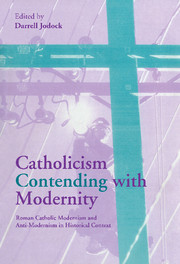 Catholicism Contending with Modernity
Catholicism Contending with Modernity Book contents
- Frontmatter
- Contents
- List of contributors
- Acknowledgments
- List of abbreviations
- Note on the text
- Introduction I: The Modernist crisis
- Introduction II: The Modernists and the anti-Modernists
- PART I THE LATE NINETEENTH-CENTURY SETTING OF MODERNISM AND ANTI-MODERNISM
- PART II MAURICE BLONDEL AND ALFRED LOISY IN FRANCE
- PART III FRIEDRICH VON HÜGEL AND MAUDE PETRE IN ENGLAND
- PART IV SOCIAL MODERNISM AND ANTI-MODERNISM IN FRANCE
- Conclusion
- Index
Introduction II: The Modernists and the anti-Modernists
Published online by Cambridge University Press: 30 October 2009
- Frontmatter
- Contents
- List of contributors
- Acknowledgments
- List of abbreviations
- Note on the text
- Introduction I: The Modernist crisis
- Introduction II: The Modernists and the anti-Modernists
- PART I THE LATE NINETEENTH-CENTURY SETTING OF MODERNISM AND ANTI-MODERNISM
- PART II MAURICE BLONDEL AND ALFRED LOISY IN FRANCE
- PART III FRIEDRICH VON HÜGEL AND MAUDE PETRE IN ENGLAND
- PART IV SOCIAL MODERNISM AND ANTI-MODERNISM IN FRANCE
- Conclusion
- Index
Summary
Who were the Modernists, and who were the anti-Modernists? Several persons who are usually included on each side of the controversy will be identified below. Our purpose is not to offer a comprehensive directory but to illustrate the variety of Modernist and anti-Modernist concerns and to introduce some of the persons discussed in the chapters that follow.
Readers already familiar with the dramatis personae may want to skip to chapter one.
THE MODERNISTS
The following are among those persons usually considered to be Modernists:
maurice blondel (1861–1949), a French philosopher. He is sometimes considered a precursor of Modernism and at other times included as a Modernist. His disagreements with Loisy regarding the relationship between biblical criticism and dogma, his readiness to arrive at orthodox conclusions, and the failure of his thinking to advance beyond its early formulations incline some to see him as a precursor. His sense of vocation and his quest for an understanding of humanity that was “open” to the divine rather than closed off from it – one that did not employ the rigid nature/supernature distinction of the neo-scholastics – incline some to see him as a Modernist. In any case, his thought influenced other Catholics with more explicit Modernist sympathies.
He is best known for his doctoral thesis, published in 1893, L'Action: essai d'une critique de la vie et d'une science de la pratique (Action: Essay on a Critique of Life and a Science of Practice) and his Lettre sur les exigences de la pensée contemporaine en matière d'apologétique (Letter on Apologetics) in 1896.
- Type
- Chapter
- Information
- Catholicism Contending with ModernityRoman Catholic Modernism and Anti-Modernism in Historical Context, pp. 20 - 28Publisher: Cambridge University PressPrint publication year: 2000
